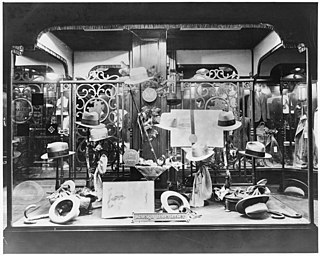Related Research Articles

The Bon Marché, whose French name translates to "the good market" or "the good deal", was a department store chain launched in Seattle, Washington, United States, in 1890 by Edward Nordhoff. The name was influenced by Le Bon Marché, the noted Parisian retailer.
Woodward & Lothrop was a department store chain headquartered in Washington, D.C. that began as the capital's first department store in 1887. Woodies, as it was often nicknamed, maintained stores in the Mid-Atlantic United States. Its flagship store was a fixture of Washington, D.C.'s downtown shopping district, competing with Garfinckel's and acquiring Palais Royal. The chain filed for bankruptcy in January 1994 and completed liquidation in November 1995, with most locations sold to either J. C. Penney or May Department Stores Company. The flagship building is a D.C. historic landmark that would become the center of controversy over competing visions for DC's urban renewal after the chain's demise, and the former service warehouse in the city's northeast is also listed as a landmark.

The Harris Company was a retail corporation, based in San Bernardino, California, that operated a chain of department stores named Harris', all in Southern California. Philip, Arthur, and Herman Harris - nephews of founder Leopold Harris of what was once the large Los Angeles-based chain Harris & Frank – started the company with a small dry goods store in 1905, and the company eventually grew to nine large department stores, with stores in San Bernardino, Riverside, and Kern Counties.
Allied Stores was a department store chain in the United States. It was founded in the 1930s as part of a general consolidation in the retail sector by B. E. Puckett. See also Associated Dry Goods. It was the successor to Hahn's Department Stores, a holding company founded in 1928. In 1935 Hahn's was reorganized into Allied Stores.
Miller's Department Store was a chain of department stores based in East Tennessee.
Frost Bros. was a high-fashion retail chain based in San Antonio, Texas. The retailer opened its first store in 1917 at 217 E. Houston Street in Downtown San Antonio. Frost Bros. was known for quality personal service, including name recognition, purchase preferences, and personal shoppers. Their customer service was on the same level as Neiman Marcus, Saks Fifth Avenue, and Nordstrom. Frost Bros. filed for bankruptcy protection in April 1988, and its four remaining stores were liquidated in mid-1989 after the company failed to successfully reorganize.

Gamble-Skogmo Inc. was a conglomerate of retail chains and other businesses that was headquartered in St. Louis Park, Minnesota. Business operated or franchised by Gamble-Skogmo included Gambles hardware and auto supply stores, Woman's World and Mode O'Day clothing stores, J.M. McDonald department stores, Leath Furniture stores, Tempo and Buckeye Mart Discount Stores, Howard's Brandiscount Department Stores, Rasco Variety Stores, Sarco Outlet Stores, Toy World, Rasco-Tempo, Red Owl Grocery, Snyder Drug and the Aldens mail-order company. In Canada, retail operations consisted of Macleods Hardware, based in Winnipeg, Manitoba, and Stedmans Department Stores, based in Toronto, Ontario. Gamble-Skogmo carried a line of home appliances, including radios, televisions, refrigerators, and freezers, under the Coronado brand name.

Garfinckel's was a prominent department store chain based in Washington, D.C. that catered to a clientele of wealthy consumers. Its flagship store at 14th and F in the city's F Street shopping district is listed on the National Register. It filed for Chapter 11 bankruptcy in June 1990 and ceased operations that year.

Fishers Big Wheel, sometimes known as just Big Wheel, was a discount department store chain based in New Castle, Pennsylvania, United States. The company operated stores under the Fisher's Big Wheel and Buy Smart names. At its peak, the chain comprised more than 100 stores in the Northeastern and Midwestern United States. The chain declared bankruptcy in 1993, selling some stores to Pamida and closing others. The chain closed in 1994.
Julius Garfinckel was a prominent American merchant, business executive and philanthropist. He was the founder of the Washington, D.C., department store Garfinckel's.

Georgetown Park is a mixed use shopping mall and condominium complex in the Georgetown historic district of Washington, D.C. The Shops at Georgetown Park are located at 3222 M Street, NW. In 2014, the complex received an $80 million renovation and is an important tourist attraction.

Raleigh Haberdasher, more commonly called Raleigh's, was a high end, local men's and women's furnishings store based in Washington, D.C.
Seven Corners Shopping Center was the first major shopping center to open in suburban Washington, D.C. It is located in Seven Corners, Fairfax County, Virginia. At its opening in 1956, it was the largest regional shopping center in Virginia. The backsplit two-story mall structure was razed in the mid-1990s and replaced with a dual ground level power center.
The Frank R. Jelleff Co., or more commonly Jelleff's was a Washington, D.C.-based retailer that specialized in women's apparel.

S. Kann Sons Co., or more commonly Kann's was a department store based in Washington, D.C. It was the District's second department store and pioneered the one-price policy and "the customer is always right" concept in retailing on the Washington, D.C. retail scene. The stores allowed consumers to return goods for cash.
Garfinckel, Brooks Brothers, Miller & Rhoads, Inc. was a Washington, D.C.-based national retail conglomerate that existed from 1967 to 1981.
Harzfeld's was a Kansas City, Missouri-based department store chain specializing in women's and children's high-end apparel.

The Shops at National Place was a three-level, indoor shopping mall located in downtown Washington, D.C. in the 16-story National Place Building. It is located on the block bounded by Pennsylvania Avenue, F Street, between 13th and 14th Streets NW, the former site of the Munsey Trust Building. It was located near the Metro Center station of the Washington Metro system.

Desmond's was a Los Angeles-based department store, during its existence second only to Harris & Frank as the oldest Los Angeles retail chain, founded in 1862 as a hat shop by Daniel Desmond near the Los Angeles Plaza. The chain as a whole went out of business in 1981 but Desmond's, Inc. continued as a company that went in to other chains to liquidate them. Desmond's stores in Northridge and West Covina were liquidated only in 1986 and survived in Palm Springs into the first years of the 21st century.

Parts of F Street and 7th Street, N.W. and nearby blocks have historically been the heart of the Washington, D.C. downtown shopping district. In the first half of the 20th century there were numerous upscale large department stores along and near F Street, while 7th Street housed more economical emporia and large retail furniture stores. The F street corridor stretches west from Downtown's Penn Quarter and Gallery Place towards 15th Street while the 7th Street corridor includes Penn Quarter, Chinatown and Mount Vernon Square neighborhoods and extends up to the border of Shaw.
References
- ↑ "'Expansive' Garfinckel to Acquire Harris," The Washington Post and Times-Herald, Jan 31, 1971, p. 115.
- ↑ "Joseph R. Harris Sr. Dies, Founded Clothing Chain," The Washington Post, Nov 20, 1979, p. C4.
- ↑ "Retailer Plans to Expand," The Washington Post, Nov 13, 1977, p. 109.
- ↑ "Garfinckel's Battles Gamble-Skogmo Takeover Bid," The Washington Post, Sep 2, 1978, p. E1.
- ↑ "Harris Family Got Premium for Stock," The Washington Post, Sep 15, 1978, p. E1.
- ↑ "Garfinckel Tells of Merger Bid," The Washington Post, Jan 4, 1979, p. D9.
- ↑ "Garfinckel Plans Sale of Joseph R. Harris," The Washington Post, Mar 29, 1979, p. C1.
- ↑ "J.R. Harris to Open New Downtown Store," The Washington Post and Times-Herald, Mar 14, 1965, p. C10.